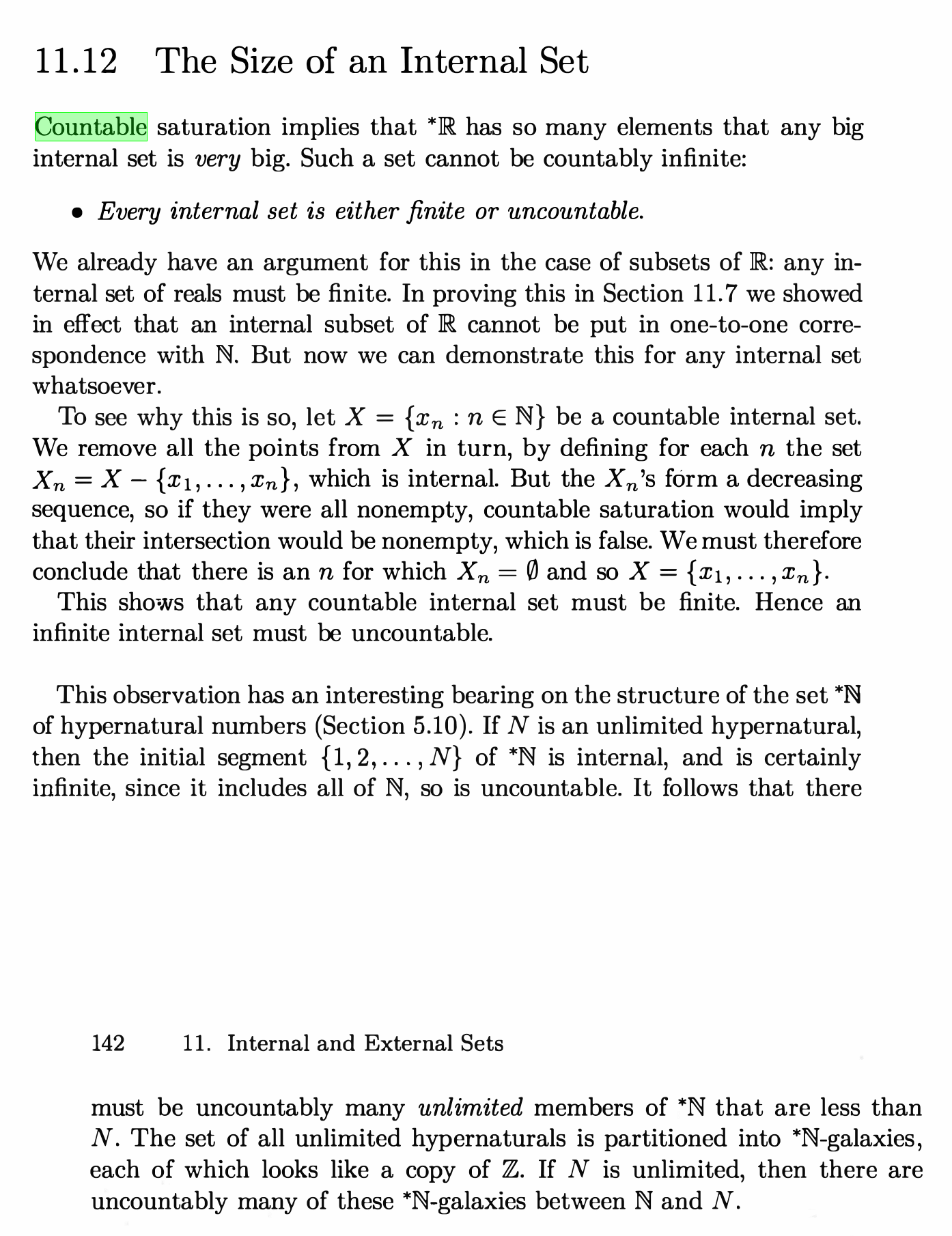"Hyperfinite" is a term used in nonstandard analysis to refer to things that are larger than all standard natural numbers but smaller than a nonstandard natural number. It's not the same as uncountably infinite.
But yes, some uncountably infinite sets can be assigned a reasonable uniform probability distribution.
There's also another sense in which some uncountably infinite spaces can be smaller than some countable spaces, namely compactness.
I used compactness in recent comment reply. Hypernaturals are uncountable because they are bigger than all the nats and so can’t be counted. Whether cardinality of continuum is equivalent to continuum hypothesis
Hypernaturals are uncountable because they are bigger than all the nats and so can’t be counted.
This isn't the condition for countability. For instance, consider the ordering of where when then . This ordering has bigger than all the nats, but it's still countable because you have a bijection given by , .
Also countability of the hypernaturals is a subtle concept because of the transfer principle. If you start with some model of set theory with natural numbers and use an ultrafilter to extend it to a model with natural numbers , then you have three notions of countability of a set :
- contains a bijection between and ,
- contains a bijection between and (which is equal to ),
- The ambient set theory contains a bijection between and .
Tautologically, the hypernaturals will be countable in the second sense, because it is simply seeking a bijection between the hypernaturals and themselves. I'm not sure whether they can be countable in the third sense, but if [1] then intuitively it seems to me that they won't be countable in the third sense, but the naturals won't be countable in the third sense either, so that doesn't necessarily seem like a problem or a natural thing to ask about.
Whether cardinality of continuum is equivalent to continuum hypothesis
Not sure what you mean here.
- ^
Is it even possible for ? I'd think not because but I'm not 100% sure.
Gonna sleep bc 3 am but will respond later. Also the remark that hyperfinite can mean smaller than a nonstandard natural just seems false, where did you get that idea from?
Also the remark that hyperfinite can mean smaller than a nonstandard natural just seems false, where did you get that idea from?
When I look up the definition of hyperfinite, it's usually defined as being in bijection with the hypernaturals up to a (sometimes either standard or nonstandard, but given the context of your OP I assumed you mean only nonstandard) natural . If the set is in bijection with the numbers up to , then it would seem to have cardinality less than [1].
- ^
Obviously this doesn't hold for transfinite sizes, but we're merely considering hyperfinite sizes, so it should hold there.
Ok, so this sounds like it talks about cardinality in the sense of 1 or 3, rather than in the sense of 2. I guess I default to 2 because it's more intuitive due to the transfer property, but maybe 1 or 3 are more desirable due to being mathematically richer.
Why would this property mean that it is "bigger"? You can construct a uniform distribution of a uncountable set through a probability density as well. However, using the same measure on a countably infinite subset of the uncountable set would show that the countable set has measure 0.
Or a counterexample from the other direction would be that you can't describe a uniform distribution of the empty set either (I think). And that would feel even weirder to call "bigger".
I thought about this since. Bigger is not the right word. Complicated maybe? Like how the unit interval contains non-measurable sub intervals, or a compact set contains non-compact subsets.
For a countable set, a uniform probability distribution is also possible by replacing the axiom of countable additivity with finite additivity. See here. It would mean each element in the countable set has probability 0.
This makes sense from the concept of potential infinity: Take a finite set of size with uniform probability distribution. As approaches infinity, the probability of each element approaches 0. Under potential infinity, a countable set is just the infinite limit of a growing finite set, so each element must be assigned zero probability. This means it almost surely doesn't happen, not that it is impossible.
The standard example is an infinite lottery. Insofar such a lottery seems possible in principle, a uniform probability distribution on countable sets must be admitted.
The video linked above also discusses other approaches. The topic has applications in cosmology.
The point is that such a distribution (uniform on countable infinite set like naturals), is not internal, and therefore external. it'll depend on the specific ultrafilter used under the hood.
for how to use it, see either alain roberts or sylvia wenmackers

For a finite set, one can describe a uniform distribution. There isn't a natural way to do so for a countable set. But for a hyperfinite set, one can describe a uniform distribution through a probability density. So in some ways the countable is "bigger".